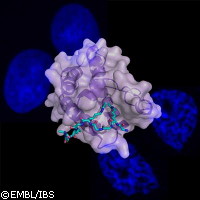Scientists crack sperm DNA code
A team of European researchers led by the European Molecular Biology Laboratory (EMBL) in Heidelberg, Germany, and Grenoble, France, have discovered that Brdt, a protein found only in developing sperm cells, plays a key role in directing the tight re-packing of sperm DNA. The results of their study, published in the journal Nature, shed light on why sperm are exceptionally streamlined. In collaboration with colleagues from the Institut de Biologie Structurale (IBS) - Jean Pierre Ebel and the Institute Albert Bonniot (IAB) in France, the EMBL researchers successfully determined how to best read the histone code by unlocking the mystery behind speedy sperm. One thing is clear: fertility relies heavily on the speed at which sperm swim. The lengthy and unwieldy nature of DNA (deoxyribonucleic acid) is conveniently packaged into a complex structure called chromatin, which is the structural building block of a chromosome. Long DNA strands are wound around proteins called histones. But what makes sperm DNA unique? The researchers said the sperm's chromatin is even more compact, effectively making the sperm's head size smaller and more hydrodynamic. Studies have shown that chromatin is regulated in a very elaborate way. Various chemical tags mark histones and act as a code to direct changes in chromatin structure. According to the researchers, 'different proteins bind to the tags, the combination of which deciphers the code'. Research conducted in the past has suggested that these proteins bind using one or more modular 'domains', with each domain being marked with only one tag. But the EMBL, IBS and IAB scientists found an extra level of sophistication. By assessing the histone binding of the Brdt protein, the team discovered that it binds most strongly to a histone with two of a particular tag - acetyl groups (carbon and hydrogen-containing groups) - but uses only one protein domain. 'We were very surprised,' said Dr Christoph Müller of EMBL. 'We looked at the structure and saw that the domain forms a pocket, binding both tags at once.' For his part, IAB's Dr Saadi Khochbin said: 'In sperm, just before the DNA starts to hypercompact, these tags are added throughout the chromatin in a huge wave. If Brdt is absent, the extra compaction doesn't take place, and the sperm head would be less streamlined. Male mice lacking Brdt are infertile.' However, the scientists said they can only speculate as to whether the manner in which Brdt binds to histone tags plays an important role in its distinct compacting ability. 'One idea is that histones acquire tags sequentially, and only compact when fully tagged,' Dr Müller said. 'Brdt binds to the last two tags in this sequence, making Brdt-binding the very last step in the process - the final signal for hypercompaction to begin.' Said IBS' Carlo Petosa: 'We re-examined the structures of other chromatin-associate proteins and saw [that] this tag-binding mechanism is likely to be used by them, too, [thus] furthering our understanding of how the histone code is read.' The scientists believe the results of their study will help to resolve problems in sperm development. The team is also assessing how this protein impacts male infertility.
Countries
Germany, France



